The restaurant business is moving fast right now, and it’s only picking up speed.
We’re seeing big shifts in how people eat, how teams run, and how tech shapes the customer experience.
It’s not only about great food anymore, but also keeping up with new habits, labor challenges, and rising expectations.
If you run or manage a restaurant, you can’t afford to ignore what’s coming.
The operators who win in 2025 will be the ones paying attention, adapting, and using trends to work smarter.
In this blog, we’re breaking down 5 key restaurant industry trends you need to know for 2025.
We’ll show you what’s changing, why it matters, and how it can hit (or help) your bottom line.
1. Smart Tech and Automation Are Reshaping Restaurant Operations
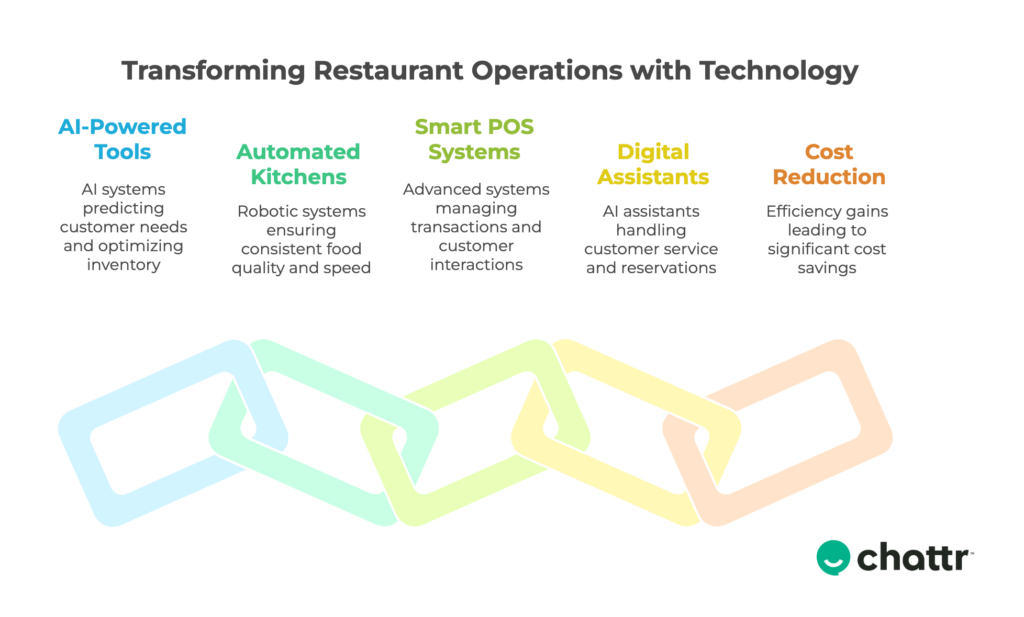
The future trends in the restaurant industry are being driven by smart technology and automation.
These innovations are not just futuristic concepts; they’re actively redefining how restaurants operate, from the kitchen to the dining area.
→ AI-Powered Tools and Predictive Ordering
Artificial Intelligence (AI) is becoming an integral part of restaurant operations.
Restaurants everywhere, big and small, are turning to AI tools to run smoothly.
These systems help predict what customers want before they even walk in. Instead of guessing how much chicken to prep for the day, predictive ordering uses past sales and real-time data to help managers make smart calls.
Less waste, more profit.
→ Automated Kitchens and Robotics
Robotic chefs and automated cooking systems are being adopted to maintain consistency in food quality and speed up service.
For instance, some establishments have implemented robotic arms for tasks like flipping burgers or assembling pizzas, ensuring precision and reducing human error.
→ Smart Point-of-Sale (POS) Systems
On the customer-facing side, smart POS systems and digital assistants are raising the bar.
Gone are the days when the register just rang up orders. Now, these systems help track inventory, recommend upsells, and even handle loyalty programs — all in real time.
Digital assistants are handling bookings, answering customer questions, and keeping things moving, which means shorter waits and happier guests.
→ Digital Assistants and Customer Interaction
Digital assistants are enhancing customer service by handling reservations, answering queries, and even taking orders.
These AI-driven systems ensure that customer interactions are prompt and accurate, improving overall dining experiences.
→ Cost Reduction and Efficiency
The integration of smart technology leads to significant cost savings.
Automated systems reduce the need for extensive staffing, lower the chances of human error, and enhance operational efficiency. This not only cuts down labor costs but also improves profit margins big time!
Some cool real-world examples:
✅ Sweetgreen’s robotic kitchen making bowls at lightning speed
✅ Chipotle’s “Chippy” robot perfecting tortilla chips
✅ McDonald’s testing AI-powered drive-thrus for faster, cleaner order-taking
Bottom line: If you’re running a restaurant in 2025, smart tech is a survival tool. It keeps your operations efficient, your team focused on delivering a personal touch, and your business aligned with the latest restaurant industry trends to stay competitive.
Read More: Smarter Hiring for Restaurants: How Conversational AI Reduces Turnover and Saves Time
2. The Workforce Revolution: A New Approach to Hiring and Retention
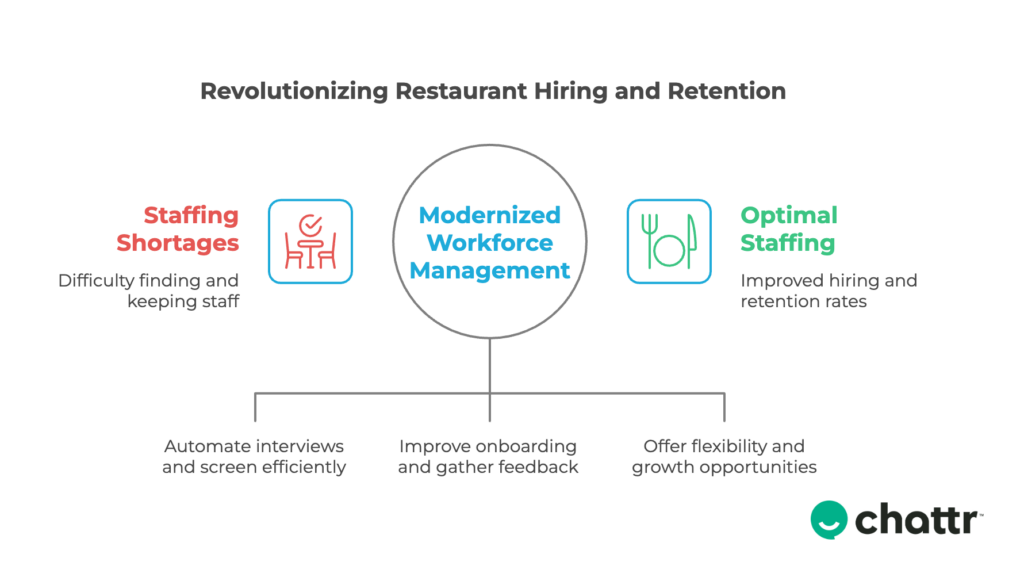
Hiring in restaurants has never been harder. Walk into any restaurant, and you’ll probably hear the same thing: “We can’t find enough good people, and when we do, they leave too fast.”
This is why the future trends in the restaurant industry are laser-focused on overhauling hiring and retention.
→ Tech is speeding things up
These days, restaurants can’t afford to take weeks to hire someone. Tools like automated interview scheduling, mobile-first job applications, and smart screening systems help teams hire faster. Chipotle, for example, is using AI to help hire thousands of workers in half the time it used to take.
→ Retention matters just as much
Operators now understand that getting someone in the door is only half the battle. The first few weeks on the job are make-or-break. Good onboarding, early check-ins, and real feedback can make the difference between someone staying and leaving.
Studies show that most turnover happens in the first 30 to 90 days, so the smartest restaurants are doubling down on that window.
→ Workers want more — and they’re not shy about it
Today’s employees want flexibility. They want to know they have a path to grow. And they want to work in places that respect them.
This means offering better scheduling tools, mentorship, and a culture that makes people feel valued.
Chattr helps bring it all together

Chattr is helping restaurant teams modernize their hiring and retention game. Its AI-powered platform screens candidates, answers questions, schedules interviews, and supports onboarding.
This cuts busywork and helps managers focus on coaching and leading, not just paperwork.
At the end of the day, the restaurants that will win in 2025 will treat their workforce like the heart of the business, not just a line item to manage.
If you’re curious to learn more about how Chattr can support restaurant and hospitality hiring, book a demo now.
3. Hyper-Personalized Dining Experiences
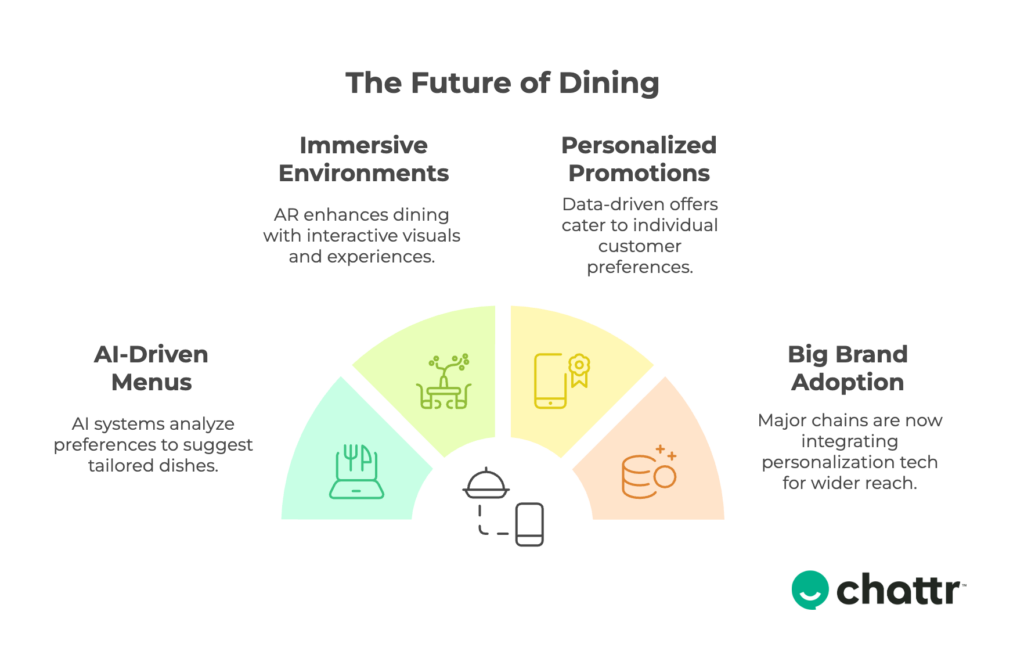
In 2025, hyper-personalization is one of the biggest restaurant industry trends shaping where people choose to eat, how often they come back, and how much they spend.
→ AI-Driven Menus and Recommendations
Restaurants are now tapping into AI to personalize the dining experience.
AI systems look at past orders, dietary preferences, and even the time of day to recommend dishes that match a guest’s tastes.
It’s smart, tailored suggestions that help diners discover something they’re more likely to love.
AI-powered ordering systems help restaurants deliver this kind of personalization at scale, improving both customer satisfaction and ticket size.
→ Immersive Environments and Augmented Reality (AR)
Personalization isn’t just about what’s on the plate.
Some restaurants are experimenting with immersive dining environments using AR. Imagine scanning a QR code and seeing a 3D visual of your meal before it arrives, or experiencing visuals that transport you to the farm where your steak was raised.
These creative touches turn dinner into a multi-sensory event.
→ Personalized Promotions and Deals
Forget generic discounts blasted to every customer.
In 2025, more restaurants are using data-driven systems to send personalized offers based on individual preferences.
If you’re a vegetarian who orders on Thursdays, you might get a special plant-based promo that day. If you’re a regular who always dines with kids, you could get family-focused deals.
→ Big Brands Getting in on the Game
Even the largest restaurant chains are joining the personalization wave.
Yum Brands — which owns Taco Bell, KFC, and Pizza Hut — is using its Byte tech platform to personalize mobile app and web orders.
4. The Sustainability Push: Greener Restaurants, Smarter Choices
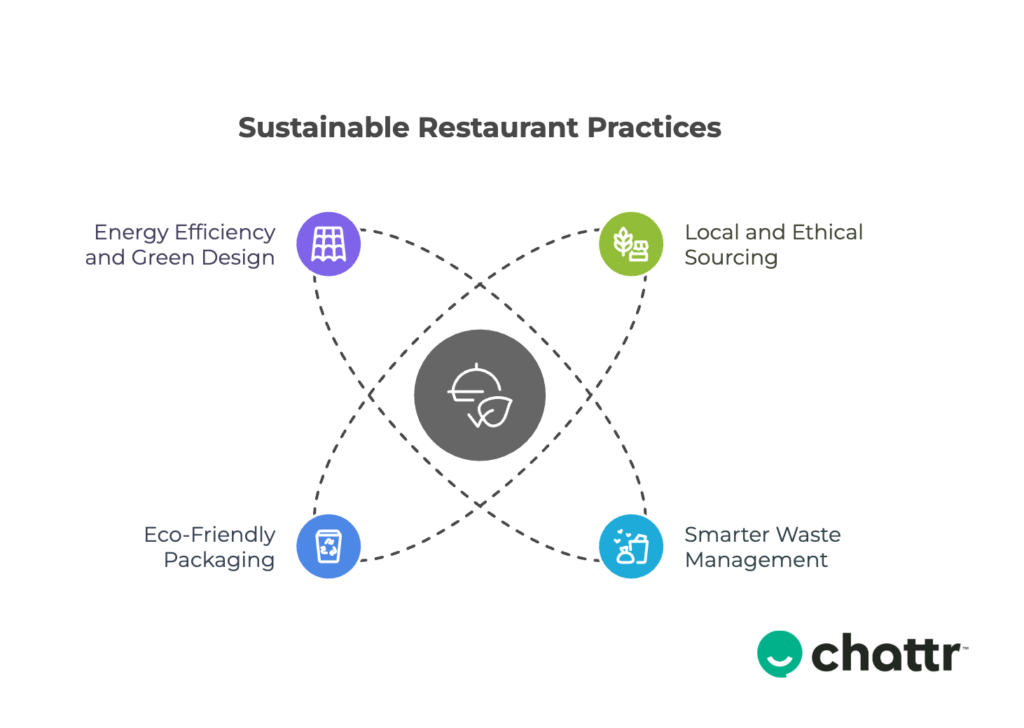
Sustainability is no longer a niche concern; it’s one of the defining restaurant industry trends today. Diners today care about where their food comes from, how it’s packaged, and how restaurants treat the planet.
→ Sourcing Local and Ethical Ingredients
More restaurants are moving toward local sourcing, not just for the marketing edge but for the real impact.
Sourcing locally cuts down transportation emissions, supports nearby farmers, and often leads to fresher, better-tasting food.
60% of consumers now say they’re more likely to dine at restaurants that highlight local or ethical sourcing on the menu.
→ Smarter Waste Management
Food waste is a massive issue in the industry, and restaurants are tackling it head-on.
Smart inventory systems track sales patterns to reduce over-ordering. Some kitchens are using AI tools to predict demand and fine-tune prep lists. Others are working with food rescue programs to make sure leftovers don’t end up in the trash.
→ Eco-Friendly Packaging
Takeout and delivery aren’t going away, but the days of plastic-heavy packaging are.
Restaurants are shifting toward compostable, biodegradable, or reusable packaging options. Brands like Sweetgreen, Chipotle, and Just Salad are already leading the charge, offering eco-friendly containers and reusable bowl programs.
→ Energy Efficiency and Green Design
Beyond the food, restaurants are rethinking their spaces.
Energy-efficient lighting, low-flow water fixtures, and greener HVAC systems help cut utility bills and shrink the carbon footprint. Some forward-thinking chains are even designing net-zero or LEED-certified locations to signal their commitment.
Sustainability is a key part of how customers choose where to spend their money, how restaurants manage their costs, and how brands shape their long-term reputation. Operators who embrace smarter, greener practices now will be the ones thriving in the next chapter of the restaurant business.
5. Ghost Kitchens and Virtual Brands Are Here to Stay
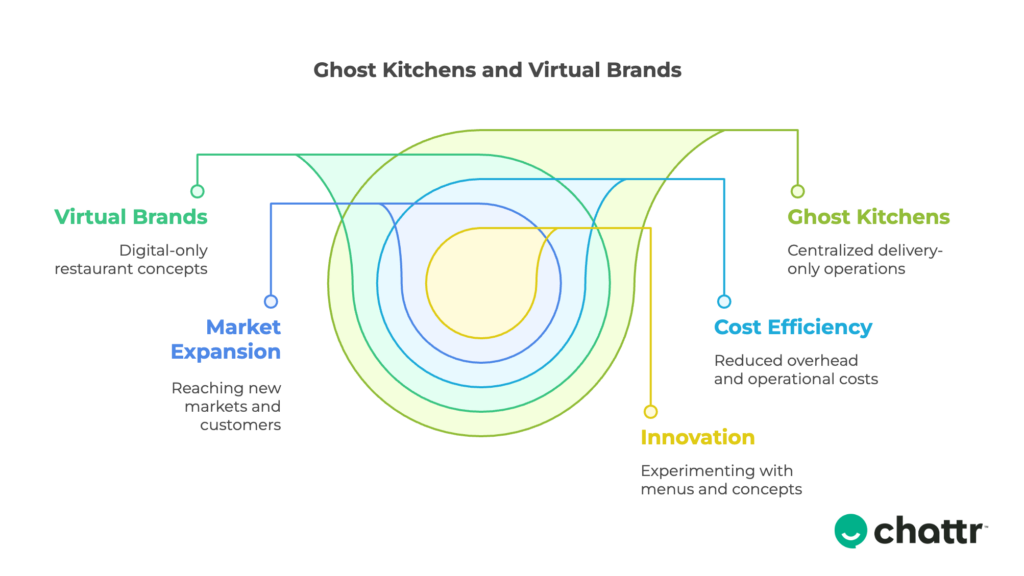
Ghost kitchens used to feel like a short-term fix during the pandemic, but they’re not going anywhere.
These delivery-only operations, sometimes called cloud kitchens or dark kitchens, are now a permanent part of the restaurant landscape. And they’re reshaping how the industry thinks about physical space, brand reach, and profitability.
→ What Are Ghost Kitchens?
Ghost kitchens are commercial cooking spaces built solely for delivery. They have no dine-in option, no storefront, and no need for front-of-house staff.
These kitchens often host multiple virtual brands under one roof, letting a single operation crank out orders for burgers, wings, salads, or tacos — all under different brand names — to maximize delivery sales.
→ No Need For Prime Real Estate
Operators love ghost kitchens because they cut overhead.
No need for a large front-of-house team or real estate. No need to pay for dining room upkeep. Instead, restaurants can test new menus, experiment with niche brands, and reach new delivery markets at a fraction of the cost.
Big chains like Wendy’s, Chili’s, and Sweetgreen are running ghost kitchen models to expand delivery reach without opening full locations. Even independents are teaming up with shared kitchen spaces to launch virtual concepts that bring in extra revenue.
→ The Virtual Brand Boom
Virtual brands are digital-only restaurants that exist entirely on delivery apps. They’re often built to target specific cravings or trends, like “late-night wings” or “healthy bowls.”
These brands help restaurants squeeze more value out of existing kitchen capacity. A pizza shop, for example, might launch a virtual pasta or dessert brand, using the same kitchen and staff but reaching new delivery customers.
Final Thoughts
There’s no “set it and forget it” in the restaurant business anymore.
The operators who thrive will be the ones who stay on top of restaurant industry trends, use smart tools, and keep adapting to what’s next.
That’s where platforms like Chattr come in.
Chattr helps restaurant teams move faster on hiring, automate the busywork, and focus on what really matters: building a team that stays, grows, and delivers a great experience every time.
So ask yourself: are you building a restaurant for yesterday… or for what’s coming next?
If you’re ready to upgrade your hiring game and see how Chattr can help, book a demo here and let’s get you set up for the future.